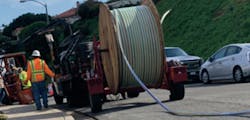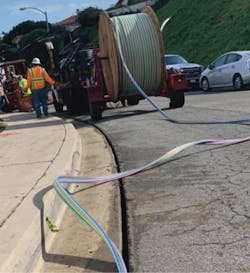Technology, Scope, Scale, Capital, Construction or…?
Whenever anyone uses the term “future proof,” I question them about what they mean, phrasing it for their age. If they were active in tech during the 1970s, the question would be “Did you foresee the way fiber optics would dominate all communications?” For the 80s, “Did you think the personal computer would become something everyone carries around in their pocket?” In the early 90s, “Could you have predicted the impact of the Internet on communications?” After Y2K, it might be about the smart phone, video streaming, FTTH, or a number of advanced communications technologies.
None of us could have predicted the future of those technologies at the time. Our predictions would have been so conservative compared to what actually happened. But many of us saw the potential in those technologies, dove right in and rode the waves!
That’s why I always question the term future proofing. That said, I do NOT question the importance of looking to the future even though we know predicting it is difficult if not impossible.
“Install more fiber than you need. Fiber is cheap, cheaper than kite string or monofilament fishing line, according to a friend who studies the fiber optic marketplace.”
When looking at the scope, scale, and costs of a communications project, it’s important to consider those things we can envision, make reminders about the questions we don’t yet have answers to, and continue to ask questions about the cost implications of both.
Fiber optic projects are usually driven by a need for communications right now. The initial concept usually comes from those who have no idea what building a fiber network entails.
When that concept needs to be executed, project planners from communications service providers (CSPs), infrastructure contractors, utilities, and/or municipalities are charged with making the concept come to life.
The Options
Thankfully there are several ways to hedge your bets for the future when it comes to building fiber networks:
Solution 1
Install more fiber than you need. Fiber is cheap, cheaper than kite string or monofilament fishing line, according to a friend who studies the fiber optic marketplace. Our own anecdotal research on rural fiber broadband says that fiber optic cable of fewer than 24 fibers is NOT cheaper than one with more fibers. In fact, a lower fiber count is more expensive. When you consider the cost of installation dwarfs the cost of the cable, justifying your purchase of cable with a higher fiber count is easy.
In urban networks, it’s becoming commonplace to install high fiber count cables. The most used fiber counts seem to be 864 or 1,728 fibers. That said, higher fiber counts can be problematic in urban areas because of the extremely large bend radius required for service loops.
Solution 2
An alternative to installing higher fiber count cables is installing more fiber ducts. We first saw this idea in New England. When the Massachusetts Turnpike Authority was faced with its third fiber construction project along the Turnpike, they required the contractor install about a dozen large fiber ducts. This ensured that the next company wanting to install fiber along the Turnpike would not require disruptive construction. They would simply pull fiber through the empty ducts. That idea spread quickly. In 2021, the “Dig Once” policy became H.R.3703 – Nationwide Dig Once Act. (Source: https://www.congress.gov/bill/117th-congress/house-bill/3703/text.) Microcables, microducts, microtrenching, and cable blowing makes “Dig Once” even easier.
Case Study
When Netly Fiber Optics started building their network in the city of Solana Beach, California, they used these strategies as part of their business model. They microtrenched along the seam between the roadway and the curb and dropped in a 6 microduct assembly. For their initial installation, they blew in a 288 fiber microcable, leaving 5 open ducts. When they need additional capacity, they only have to blow in more 288 fiber cables, to a total capacity of 1,728 fibers along any street in the city. (See Figure 1.)
What Netly did in Solana Beach was much more radical than planning for future cable installations. Netly’s business model is to create an open-source fiber optic network where every potential user in the town has their own dedicated fiber. Their headend office has a fiber connection to every potential user, not just FTTH customers, but businesses, government offices, traffic lights, current, or future cell sites, etc.—about 30,000 fibers for a town of 6,000 residences.
Netly is not a service provider, they are a fiber provider. Their headend can host equipment from multiple ISPs, CATV companies, cellular providers, and others in addition to the city departments. Connecting to a service point just requires running a patchcord from the service provider’s equipment to the appropriate fiber for the customer. Changing service providers is as simple as changing patchcords. (See Figure 2.)
That open-source model, coupled with the use of standard singlemode fiber enables upgrades to terabit speeds, a thousand times faster than most current networks. That has led to Solana Beach being called the first “Terabit City.”
Future Proof?
How long will the Solana Beach network be able to handle traffic? Today’s singlemode fiber technology is already 40 years old and still going strong, even as network speeds have increased almost a million times. Today’s cables are likely good for a lifetime of another 40 years. It’s anybody’s guess what communications networks will look like in 2063, so calling Solana Beach ‘future proof” is still premature.
We also know most fiber deployment projects are constrained by a budget. The Netly business model attempts to address this in a different way. With the cost of fiber optic cable being a small fraction of the construction costs, this alternative model opens leasing to multiple service providers, utilities, munis, and others. This approach helps rationalize that CAPEX. What’s more, the company is backed by venture capital.
Perhaps that’s the bigger picture of future proofing. It’s not all about technology.
About the Author
Jim Hayes
Fiber Optic Expert
Jim Hayes is the Fiber Optic Expert columnist for ISE Magazine. He is a lifelong techie who has been involved in the fiber optic industry since the late 1970s. He founded one of the world's first fiber optic test equipment companies, FOTEC, which was acquired by Fluke in 2000, and he was a co-founder of the Fiber Optic Association (FOA), the international professional society of fiber optics, in 1995.
Jim is a writer and trainer and the President of FOA. He is the author of nine books on fiber optics and cabling and writes for several magazines.
Jim and his wife, Karen, who is the GM of the FOA, have traveled the world for the FOA helping set up schools to train the workers who design, build, and operate today's communications networks. The FOA offers nearly 1,000 pages of online technical materials, over 100 videos, and two dozen free self-study courses online.
For more information, email [email protected] or visit www.jimhayes.com.
To learn more about The Fiber Optic Association, visit www.thefoa.org. Follow them on Facebook: FiberOpticAssociation, LinkedIn: company/the-fiber-optic-association-inc-foa, and YouTube: user/thefoainc.



